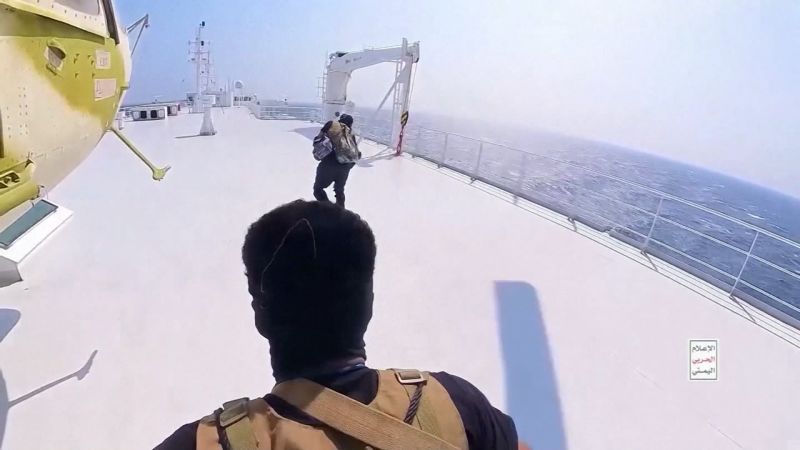US warships in the Red Sea have been battling a growing number of weapons fired by Houthi forces in Yemen over the past several weeks, including 17 drones and missiles during a 10-hour period on Tuesday alone.
Yahya Sare’e, a spokesman for Houthi forces, said on X, formerly Twitter, that the latest launches were in “continued support and solidarity with the Palestinian people.” The group had previously said it was targeting ships headed for Israel following Israeli forces’ invasion of Gaza.
The Iran-backed Houthis have launched at least 100 attacks against 14 different commercial and merchant vessels in the Red Sea over the past month, a senior US military official said last week.
The strikes prompted US Defense Secretary Lloyd Austin to announce the formation of a coalition of at least 10 countries to focus on security in the Red Sea.
The coalition involves member ships being available near the Red Sea to respond to attacks. A goal of the initiative was to deter future Houthi attacks, but the militants have nevertheless continued targeting ships operating near Yemen.
The Red Sea is home to one of the most important maritime trade routes in the world, and the attacks have had far-reaching reverberations. At least 44 countries are connected to vessels attacked by the Houthis and the attacks have disrupted wider international trade.
The 17 drones and missiles launched by the Houthis on Tuesday were brought down with weapons carried by the guided-missile destroyer USS Laboon and by F/A-18 fighter jets flying off the aircraft carrier USS Eisenhower, the US Central Command said.
The US Navy has not said exactly what weapons its ships are using against the Houthi attacks, but analysts said a US destroyer has a range of arms systems at its disposal.
These include surface-to-air missiles, explosive shells from the destroyer’s 5-inch main gun and close-in weapons systems, the experts said. They also said US ships have electronic warfare capabilities that could sever the links between drones and their on-shore controllers.
Whatever systems US destroyer captains use, they face decisions on cost, inventory and effectiveness as the mission grows, the experts said.
“The drones are slower and can be hit with the cheaper missiles or even the ship’s gun. Faster missiles must be intercepted with more sophisticated interceptor missiles,” said John Bradford, Council on Foreign Relations International Affairs fellow.
US Navy’s main asset – the guided-missile destroyer
The main US asset involved in the Red Sea to counter the attacks on shipping is the Arleigh Burke-class guided-missile destroyer, like the USS Laboon. The missiles in its magazine include:
• The Standard Missile-6 (SM-6), an advanced weapon that can shoot down ballistic missiles high in the atmosphere, other lower trajectory missiles and target other ships with a range of up to 370 kilometers, according to the Missile Defense Project at the Center for Strategic and International Studies (CSIS). These cost more than $4 million each.
• The Standard Missile-2 (SM-2), less advanced than the SM-6 with a smaller range of 185 to 370 kilometers, depending on the version, according to the CSIS. They cost about $2.5 million each.
• The Evolved Sea Sparrow Missile (ESSM), designed to hit anti-ship cruise missiles and lower speed threats like drones or helicopters at a range of up to 50 kilometers, the CSIS says. Each one costs more than $1 million.
Experts said last week they think the US is using the SM-2 and/or ESSM missiles against the Houthi threats so far.
Pricey munitions and the cost-benefit ratio
But as they are facing drones that can be produced and deployed in large numbers for unit prices well under $100,000, a prolonged campaign could eventually tax US resources, the experts say.
“These are advanced air intercept capabilities with an average cost of around $2 million – making the intercept of drones not … cost effective,” said Alessio Patalano, professor of war and strategy at King’s College in London.
Houthi forces are funded and trained by Iran, so they have resources for an extended fight, the experts point out.
It’s also a question of to what lengths the US wants to go to protect merchant shipping, the analysts said.
A US destroyer’s Phalanx close-in weapons system – Gatling guns that can fire up to 4,500 rounds a minute – could handle drone or missile threats that get within a mile of the warship, said Carl Schuster, a former US Navy captain and a former director of operations at the US Pacific Command’s Joint Intelligence Center in Hawaii.
That’s a relatively low-cost defense. But if drones do get that close, it is the last line of defense and a miss could cost US lives.
“A single missile or single drone does not sink a US warship, but it can kill people and/or do damage that required the ship to withdraw for repairs in port,” said Bradford, from the Council on Foreign Relations.
Defense of warships vs. protection of merchants
And the Phalanx system can’t protect merchant ships the US destroyer may be watching over, sailing miles away from the warship.
“To provide wide area air defense (as opposed to self-protection) vessels rely primarily on anti-air missiles,” said Sidharth Kaushal, research fellow for sea power at the Royal United Services Institute in London.
Kaushal said US anti-aircraft interceptor missiles on US warships are fired from vertical launch system (VLS) cells on the deck.
Each cell can contain a mix of armaments (exact numbers are classified), but the number aboard any one vessel is finite, Kaushal said.
And if the Houthis can deplete a ship’s inventories with successive attacks, the warship could find itself short on munitions to protect the merchant vessels it’s watching over, said Salvatore Mercogliano, a naval expert and professor at Campbell University in North Carolina.
“While the navies are well equipped to swat down what the Houthi are currently throwing, the fear is that the scope and scale increase and the escorts cannot keep up a level of defense to protect commercial shipping,” he said.
The Houthis have not yet tried a true drone swarm attack – similar to what Russia has deployed repeatedly in Ukraine – one that could involve dozens of incoming threats at one time, the experts said.
“A swarm could tax the capabilities of a single warship, but, more importantly, it could mean weapons get past them to hit commercial ships,” Mercogliano said.
US warships also face the question of how to replenish missile inventory in the region, he said.
“The only site to reload weapons is at Djibouti (a US base on the Horn of Africa) and that is close to the action,” he said.
Possible threats in an evolving battlespace
The experts said deployment of anti-ship cruise or ballistic missiles presents a potentially more difficult challenge. Houthi forces fired three anti-ship ballistic missiles, and two land-attack cruises missiles on Tuesday, US Central Command said.
Anti-ship cruise missiles “can come in low and penetrate a ship’s hull above the waterline. These are the type of weapons that sunk several British ships during the Falklands War and hit USS Stark (in the Persian Gulf) in 1987,” Mercogliano said.
Ballistic missiles could present an even greater danger, he said.
“The terminal velocity of the weapon and its payload could inflict serious damage” on a warship or commercial vessel, he said, and may need the best US interceptors, like the SM-6, to shoot it down.
Mercogliano said the battlespace is not static and the Houthis will have something to say about what they will deploy.
“The Houthi are watching and seeing how the navies are responding to these attacks,” he said.
And the experts say the US may at some point decide it has to go on offense.
“There is another course of action which is striking at the source. This would shift the emphasis from intercepting the capabilities once they’re in the air to strike them at the source to prevent their use in the first place,” Patalano said.
“Given a choice and capability, it is always cheaper to take out the archers than to intercept the arrows,” Schuster said.





























